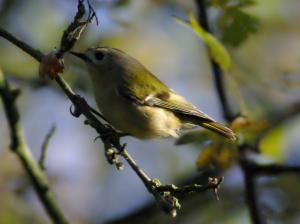


The Goldcrest is Nottinghamshire's smallest and lightest bird, it was called the Golden-crested Wren by Sterland in his Birds of Sherwood Forest {1869} where he regarded it as a constant resident, though more plentiful in winter than summer
, pretty much the same as the present time. Many birds arrive in Nottinghamshire from Scandinavia in the late autumn, carried across the North Sea by hiding in the plumage of Woodcocks (or so legend tells us), hence another name for the Goldcrest of ‘Woodcock pilot’.
It much prefers conifers, but will be present in broad-leaf woodland if there are pine trees present. In Nottinghamshire it is well distributed in both summer and winter and often to be found amongst yew trees in church yards. It is mainly an arboreal feeder, but sometimes will feed on the ground, especially in winter.
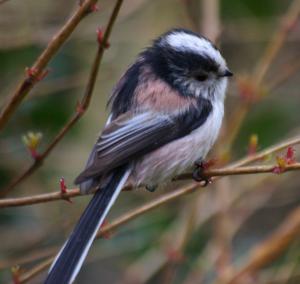
The Long-tailed Tit is a very common resident in Nottinghamshire, breeding mainly in scrubby areas, but in winter will also use trees such as ash, sycamore and oak for feeding. The population of Long-tailed Tits has risen by about 30% in the last 15 years in the East Midlands. When breeding the main pair of Long-tailed Tits often have one or two 'helpers' (often failed breeders) to assist in raising the young.
The number of Long-tailed Tits is halved by the time spring arrives in an average winter, but can be reduced by 80% in a harsh one. In the winter forms tight flocks, often with other tit species. The area covered by a flock is normally something like 20 hectares (40 acres), larger flocks having larger territories. A normal winter flock consists of around 8 or 10 birds, usually parents, helpers and young from the previous breeding season. A larger flock is usually an amalgamation of two or more family flocks.
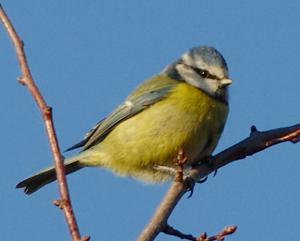
One of the commonest birds in Nottinghamshire, occurring in gardens, parks, anywhere with a few trees, especially oak, but it is not as frequently found in coniferous woods. The population of Blue Tits has increased slightly over the past 15 years. It has always been a common resident in Nottinghamshire since the mid-nineteenth century.
It will form flocks with other tit species in the autumn and winter. In the spring and summer it is very territorial.
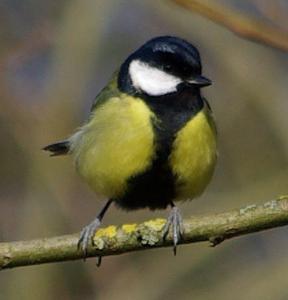
The Great Tit is Nottinghamshire's second commonest tit after the Blue Tit. It is found in much the same habitat as the Blue Tit and but feeds rather more on the ground than that species. Sterland in the "Descriptive list of the birds of Nottinghamshire {1879}" said that it was very abundant in gardens
. In the 2009 edition of the Breeding Birds Report it shows that the Great Tit has increased by 80% in the years between 1995 & 2008 in the East Midlands.
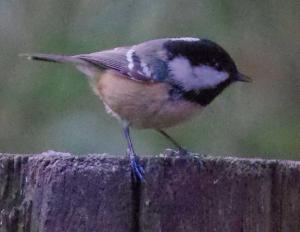
Coal Tit population in Nottinghamshire is stable and it is regarded as a fairly common resident. Sterland in the "Birds of Sherwood Forest {1869}" says that the Coal Tit is far from uncommon, but it is exclusively a denizen of our woods and plantations
, a situation similar to the present day. It is just as much at home in the commercial pine plantations as in the oak woods, consequently in Nottinghamshire it can be seen in place such as Wollaton Park, the pine woods of Moorgreen/Annesley and the forests of the Dukeries.
Unlike the Blue Tit, the Coal Tit will cache food, probably an adaption from living in pine, spruce and birch woodlands with their unreliable seed crops. The Coal Tit looses out to Blue Tits in direct competition with it for food and breeding sites, but has the advantage over the Blue Tit in coniferous woods with its thinner bill, enabling more efficient probing and longer claws on its feet giving it better mobility around the trees, relying less on ‘hanging’.
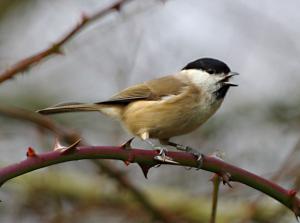
Described by Dobbs (The Birds of Nottinghamshire {1975}) as a Fairly common resident
, its numbers have declined since. Research from the BTO indicates that Marsh Tit numbers have declined by 20% between the years 1995-2008.
Prefers more mature woodland than the Willow Tit, Oak woods are very suitable for this species, and so it is commoner in the Dukeries area of Nottinghamshire, but still can be easily found in some southern areas (Attenborough for instance, to which it has recently returned). It prefers an adequate understory area, to the part of woodland which has an open floor (Swithland wood in Leicestershire shows this). Birds will remain on their breeding territory through the winter, this territory can be large – 3 ha (6 acres).
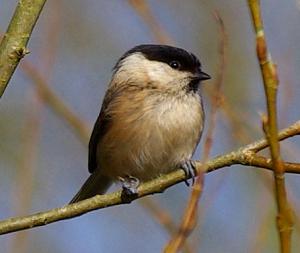
The Willow Tit is classed as a ‘red-listed’ bird in Britain and its numbers have declined by 70% in the period 1995 – 2008. Nottinghamshire has not escaped these declines and it has almost disappeared from areas where it was once common (Attenborough and Bennerley).
Found in more damp places than the Marsh Tit preferring Alder and Willow carr to breed, it excavates its own nesting hole. In the winter the breeding birds remain on their territory, using food caches as an aid to staying alive. Using a food cache is also thought to be one way of avoiding too much direct competition with Great and Blue Tits to which it is subservient. It is mainly sedentary throughout the year and there is little influx or exodus in the winter.
Any criticisms, corrections or comments to the author Derek Huskisson

This work is licensed under a Creative Commons Attribution-Noncommercial-Share Alike 2.0 UK: England & Wales License.